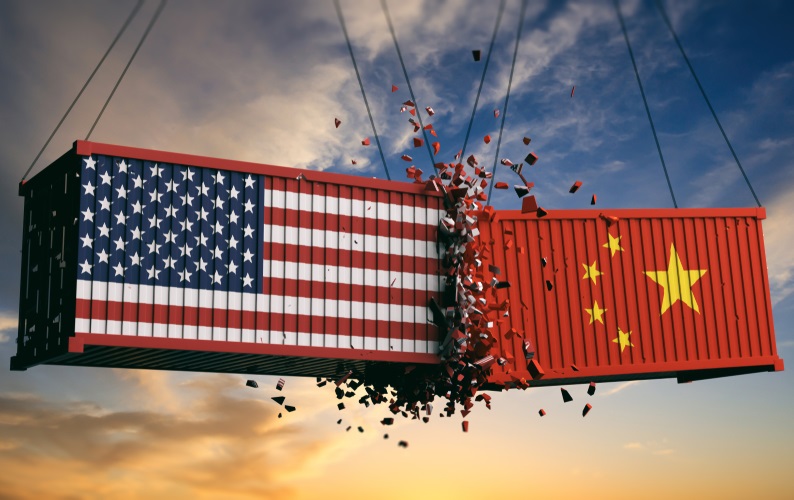The Greater Impact of the US-China Trade Tensions
Looking into how and when these trade tensions will end
Tim Doyle //July 30, 2019//


The Greater Impact of the US-China Trade Tensions
Looking into how and when these trade tensions will end
Tim Doyle //July 30, 2019//

On May 10, trade tensions between the United States and China escalated with the U.S. raising tariffs from 10% to 25% on $200 billion worth of Chinese goods. The current administration is also contemplating tariffs on all Chinese imports (worth $540 billion). China retaliated by announcing plans to impose tariffs on $60 billion worth of American products.
Trade tensions between the U.S. and China are a primary concern leading into the remainder of 2019. This article is intended to offer some perspective on the current trade tensions between the world’s two largest economies.
When looking at impact, it is important to note that exports make up roughly 8% of GDP for the United States and 19% of GDP for China. By comparison, exports in Japan, the U.K., Canada and Mexico are 15%, 17%, 26% and 38% of the respective GDPs. It may be surprising to some that China’s exports (measured as a percentage of GDP) are in line with countries and regions like the U.K., Japan and much of the Eurozone.
Technically speaking, China is more reliant on the U.S. for export activity than the other way around, but the U.S. may be overestimating a perceived weakness in China’s position.
China is the second largest economy in the world based on Nominal GDP of over $12 trillion and the largest based on GDP (PPP/Purchasing Power Parity) of over $23 trillion. Comparatively, the U.S. has Nominal GDP and GDP (PPP) of roughly $20.5 trillion. China’s GDP growth has slowed from 6.8% in early 2018 to about 6.4% in the first quarter of 2019. Still, China’s first quarter GDP number was slightly above market expectations due to growth in industrial output and strengthened consumer demand.
The current tensions between the U.S. and China remind me of a story involving my childhood friend, Ben, and his little brother, Matt. Matt was about five years our junior and, as tends to happen with little brothers, he was the recipient of some friendly “little brother hazing.” Matt chased down baseballs, retrieved sodas and was generally subservient to the whims of Ben and our crew of friends. Years later, when in college, I arrived home for a semester break to find that little Matt had suddenly grown into a 6-foot, 200-pound young man. Quite literally, the scales had suddenly shifted, and the days of Matt’s subservience and timidity were over.
My point is that China is likely no longer the deferential country or economy it might’ve been in 2005, when the country’s GDP was $2.2 trillion, and exports represented roughly 30% of GDP. President Xi Jinping also has the advantage of being able to play the political “long game,” as he essentially has a lifetime appointment. Conversely, the current administration is facing elections in November of 2020. Will President Xi allow these trade tensions to persist until he can potentially find a more cooperative and amenable administration when it comes to trade relations?
Now back to the numbers ̶ assume that the new Chinese tariffs flow directly into the price of consumer goods. This would amount to a price increase of “just” $30 billion ($200 billion x (25%- 10%) in a consumer economy of roughly $14 trillion, or about .22%.
Furthermore, it is expected that some of the cost of this tariff increase will be incurred by retailers and importers, further reducing the direct impact on consumers. From a capital markets perspective, these numbers aren’t insignificant, but the true damage caused by these tariffs may not be in the numbers themselves, but in the global economic uncertainty that is caused by a rift between the world’s two largest economies.
Lately, we’ve seen volatility in global financial markets, world trade volume has dropped dramatically and heavy manufacturing countries and regions like Taiwan, Korea, Mexico and the Eurozone are starting to feel the pinch with manufacturing PMI’s in contractionary ranges.
It is impossible to predict how and when these trade tensions will end, only time will tell.
Tim Doyle is the senior wealth management coordinator at Destiny Capital.
This article is intended for general informational purposes and does not constitute a recommendation of any type. Please seek advice from your tax, legal, and financial professional prior to taking action. Securities Offered through Destiny Capital Securities Corporation, member FINRA/SIPC
























